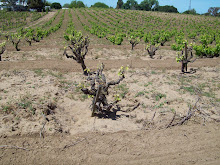
That’s because building the cocktails is my job!
Sorry for the sucky Christmas Day photo of our 17-year-old, kitty chemo patient being comforted by my hand-knit sock monkey present from Santa. Yeah, it’s a bit “Tiny Tim, ‘Deity of your choice’ bless us, every one,” but as we’d just watched “The Muppet Christmas Carol” the night before — the only version of the Dickens classic that Kathy can stomach, BTW (love the in-jokes, especially the sign on the building in the background, “Micklewhite & Co,” a nod to Michael Caine’s real surname) — well, ‘tis the season for treacle and suckiness.
In the decades that Kath and I have been together, we’ve whittled our Christmas traditions down to a few standards of presents, rituals and meals for the holiday season, since it’s just the two of us. It starts with a de rigueur viewing of the Pee-wee’s Playhouse Christmas Special on Thanksgiving, putting up the tree mid-December and an obligatory Christmas morning gift exchange of brand-new flannel pajamas and two-player board games.
Christmas meals have been similarly honed to delicious regimen. We’ll have a Dungeness crab pasta dish on Christmas Eve, and, invariably, a slow-cooked salmon fillet plated with a chunky, spicy cherry/jalapeño/lime/cilantro salsa for Christmas dinner. I grew up in Canada with the stuffed turkey thang (of course, Canuck Thanksgiving is the first Monday in October; as a kid, I could never understand “Miracle on 34th Street” with Santa at a Thanksgiving parade.), so it came as a big surprise to me when our unique and contrarian Christmas meal plan would, in the last few years, often result in Costco, of all places, running out of salmon and/or Chilean cherries. And now that we’re in the far East Bay of Northern Cali, as opposed to Seattle where Kumamoto oysters are virtually on tap, the hunt for fresh salmon and crab, never mind out-of-season cherries, required Kathy to plan our December 24 grocery shop with military precision.
Since the Asian market in Antioch closed this summer (their landlord went into foreclosure), our source for live crab dried up; we’d have to hope that our local outpost of the Raley’s supermarket chain had cooked Dungeness available, since the weekly circulars made no mention of it. Kathy set the alarm for 7 a.m. Christmas Eve, and while I ground the coffee beans, she pored over recipes for new side dishes, and made the list for our classics. And, yeah, she did check it twice.
Before jumping in the shower, she had me call Raley’s to see if they had crab. “Yes, ma’am [I have that kind of voice],” Bob the pleasant seafood manager told me, “and we have plenty.” Kath was still nervous, and we soon hit the road, with the supermarket our first stop. We split up once inside: Kathy to get crab and chicken livers (sautéed in raspberry vinegar with crème frâiche makes a heavenly breakfast), I to try to find cherries. All kinds of imported berries in those plastic clamshells, but no cherries; then, as I was about to give up, I spotted zipper bags of imported cherries beside the grapes. $6.99 per pound, but we’d been burned by Costco before. I grabbed a bag and reconned with Kath.
Next stop: Costco. Last year, we thought they opened at 11 per our membership level; they had opened at 10. This year, we got there shortly after 10 only to discover that they had opened at 9. Kathy went salmon fillet fishing; I hit produce to check for cherries. Good thing we found them at Raley’s; Costco had none. They were even out of limes. Luckily, I’d stocked up on citrus earlier in the month; we did not want this to be the Year Without a Margarita. Plenty of salmon and steelhead, though. As we’ve done for the last few years, we bought an extra fillet to smoke on Christmas Day in our Big Chief electric smoker.
Final stop: Trader Joe’s, for all those funky little gourmet extras, such as haricots verts and Meyer lemons. There’s a relish from one of Alice Waters’ Chez Panisse cookbooks that uses Meyer lemons, but this year, we’ve decided to use ‘em for Lemon Drops.
Hope y’all had a nice December 25; Kath and I did. Christmas jammies and board games, chicken livers and board games, a round of afternoon cocktails while listening to a Kevin Pollack Chat Show podcast, a slow-roasted salmon fillet with blueberry-cherry salsa and green beans with bacon vinaigrette, and paired perfectly with a 2009 “Vin Gris of Carignane” from 3 wine company.
It’s a rosé from CoCo grapes that preens a beautiful salmon color, appropriately enough, considering the food pairing, with tints of strawberry fruit and cranberry juice. The nose is all floral notes of cherry, rose petal and that ubiquitous cranberry. There’s nothing subdued about the mouthfeel, echoing its darker coloring: lots of cane berry fruit and bashful acidity providing a long finish. It’s a rosé in no way content to hide in the shadows of the genre.




















